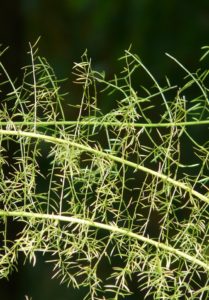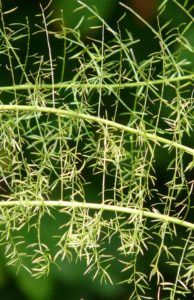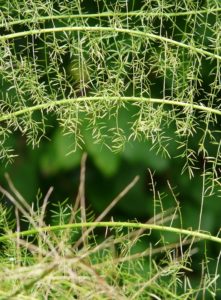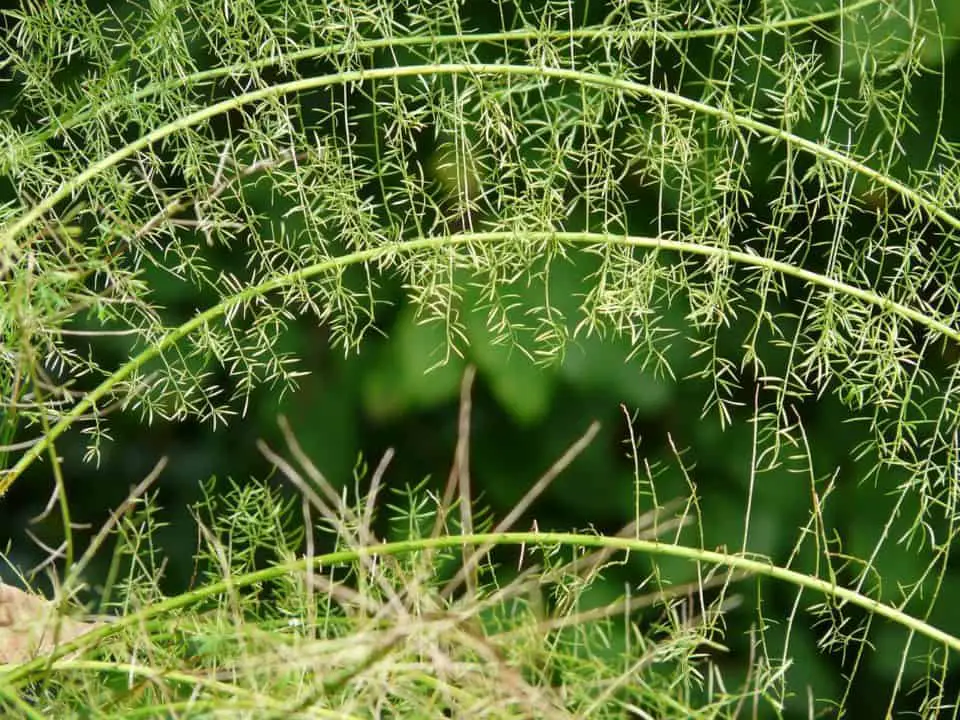Some links in the post are affiliate links and I get a commission from purchases made through some links found in the post.
Asparagus Ferns are evergreen ornamental plants. They are commonly called lace ferns or climbing asparagus.
It is a climbing plant of the genus Asparagus. The plant is native to South Africa.
Although it is named a fern, the plant is not a true fern, it is so-called because its leaves have the appearance of a fern. Its botanical name is Asparagus setaceus.
The plant is easy to grow, fast-growing, and very low maintenance. These ferns are quite drought-resistant and hardy and can easily survive harsh conditions.
Asparagus fern creates long and upstanding fanning stems. The stems are covered with few sharp, hardened spines on the axils.
The fern-like spiky fronds give it a thick, padded, and bushy appearance. They can also give little blossoms and berries if grown properly.
These berries are only for visual fascination and seeds and are not for eating. They add a pop of green whenever they are planted indoors.
For indoors the plants are kept in baskets and containers. In hotter areas, the greenery can be effectively adjusted to open air, where it develops like a creeper and can even get invasive.
How to Grow Asparagus Ferns from Tubers?
 Asparagus ferns are propagated from tuberous roots that grow just underneath the topsoil.
Asparagus ferns are propagated from tuberous roots that grow just underneath the topsoil.
They can be grown by separating and replanting these tubers. It is the simplest and most effective approach to get a greater amount of these ferns.
Follow these steps to grow asparagus ferns from tubers:
1) Dig out the Tubers
Take a well-grown asparagus fern with an established tuberous root system.
Burrow a wide opening almost 5 inches around the plant with your hand or a spade. Push the spade beneath the plant and lift the tubers.
2) Water the Tubers
Water and soak the tubers before planting. This accelerates their growth process.
3) Divide the Tubers
The roots and tuber system can be propagated as such can be cut or divided into small pieces according to the pot size. We will go over how to divide the tubers below.
4) Plant the Tubers:
Plant the tubers in a peat mix soil. Water the soil profusely and then allow the excess water to drain out from the bottom.
Tubers need moist conditions to germinate properly.
How to Divide Asparagus Fern?
Asparagus fern plants can be easily divided since these plants grow in clusters.
The propagation is done by separating all the crucial parts of the plants including the leaves, stem, and root.
This encourages the formation of a new healthy plant and prevents overcrowding of roots. It is also useful to prevent the plant from becoming pot-bound.
The most suitable time to divide the asparagus fern plant is from the early spring to late summers. So the time from March to August is ideal for this purpose.
During this period the roots and stems of the plant are stern and hardy and can withstand harsh environmental conditions. Follow these steps to divide the asparagus fern:
1) De-potting the Fern
First, isolate the dirt of a potted asparagus fern. Pull out the plant delicately out of the pot or the compartment where it is encased.
Then uncover the roots tenderly by setting the plant under running water. Eliminate large soil particles by hand without harming the delicate roots.
2) Dividing the Fern
Cut the fern into two halves from the leaves to the tubers. In this way, you have two separate ferns.
3) Placement into the Container
Place the halves in separate pots containing coco peat and worm casting soil mix.
Press in soil from the top and cover the roots and tubers completely. Water and let the plant grow.
If you are enjoying this article, check out how to save a dying staghorn fern.
How to Propagate Asparagus Fern from Seed?
Asparagus ferns are very easy to grow at home when the seeds taken from the berries are utilized.
They won’t develop from cuttings or twigs like numerous other normal foliage plants.
These seeds can form in any season. Asparagus fern berries show up after their white flowers are shed.
Common asparagus ferns blossom in pre-fall or pre-winter, while foxtail ferns sprout in pre-summer to early summer.
The little, round berries begin light green and mature to a splendid red color when ready. These berries commonly develop on asparagus ferns grown outside.
They hardly ever grow on ferns placed inside. The seeds can be pretreated and planted or put away in a water/airproof container inside a cooler for later planting.
Follow these steps to grow your fern from seeds:
1) Pick the Berries and Take Out Seeds
Accumulate the berries once they take on a uniform red tone and the skin shows up somewhat wrinkled.
Next eliminate the little, dark seeds from ripe asparagus fern berries.
Just crush the berries until the seeds jump out. Look over the seeds and dispose of any with clear indications of damage.
2) Soak the Seeds
Soak the seeds in a cup of warm water for 24 hours before planting. This makes the seeds absorb water and grow more efficiently.
3) Plant the Seeds
 Plant the seeds in 3-inch plastic pots loaded up with a slightly acidic blend, for example, a peat blend.
Plant the seeds in 3-inch plastic pots loaded up with a slightly acidic blend, for example, a peat blend.
Soak the dirt before filling the pots, leaving the top inch of the pot unfilled.
Press a few asparagus plant seeds onto the outside of the soil blend.
Cover them with a slight layer of soil so they are delicately covered yet, at the same time, can be seen from above.
The seeds don’t need base warmth to grow. Keep the blend a little wet. These seeds take about three weeks to about a month to sprout.
Conditions Required for Asparagus Fern Growth:
1) Sunlight
Asparagus ferns grow well in splendid light but without direct exposure. Direct, hot daylight can burn and scorch the leaves.
On the other hand, lack of light will make them yellow or droopy in appearance.
They flourish in temperatures ranging from 70°-75° F in the daytime and 10 degrees cooler around evening time. Wide temperature fluctuations can cause its leaves to shed.
If your plant is struggling due to light, trying using this to help regulate the lighting.
2) Soil
They need rich, light, and slightly acidic soil and it should also be well-drained. Peat moss soil provides these ideal conditions.
These ferns can easily endure brief periods of the dry season if they ever occur.
3) Watering
Asparagus ferns develop best when they are given a lot of water, particularly when they are effectively developing.
In low light conditions, the plant will require less water, particularly throughout the cold weather months. They like higher dampness and periodic moistening.
If you need help watering your plant, try using this automatic drip irrigation kit.
4) Fertilizer
In the warm season, the plant needs to be taken care of consistently. The plant needs either fluid compost or all-purpose plant food diluted to half its potency.
Try this easy to use fertilizer to give your plant that little boost.
You may also like: how to make homemade fertilizer for ferns
Maintaining Proper Care of Asparagus Ferns:
Asparagus is not a high-maintenance plant, but it still requires a loving hand of care. Following steps should be taken to maintain the ferns:
1) Trimming
Trimming removes the old yellow leaves and keeps your fern looking fresh and new.
2) Repotting the Fern
Because of the root tubers being able to grow quickly, asparagus ferns can quickly become pot-bound. To avoid this, repot your plant once every one or two months.
Care should be taken while handling these plants. The plants have short thorns that could hurt your fingers so they should be handled with gloves.
They serve as excellent container plants or vase plants.
3) Growth Restriction
They are quite hardy plants and resistant to pests and insects. They are called weeds in certain areas like Queensland etc, so their growth should be restricted to a small area.
Unchecked growth can cause them to override neighboring plants.
Final Thoughts
 Asparagus ferns are beautiful plants that are very easy to propagate from tubers and can grow quickly by following the simple steps mentioned above.
Asparagus ferns are beautiful plants that are very easy to propagate from tubers and can grow quickly by following the simple steps mentioned above.
They need regular watering once they’ve started to grow. The only caution is that they can encroach other plants in your garden.
So, it is better to plant them in a separate pot and grow them indoors.
It is poisonous to pets and doesn’t like being touched a lot. You can adorn your window sills with the asparagus fern where your pets can’t reach them.
Before you go, here are some more related articles I encourage you to read below to help solve more of your gardening issues:
What are the Benefits of a Boston Fern
How to Stop Your Boston Fern Leaves Curling
Why Does Your Fern Smell Like Fish and How to Fix it
Can I grow ferns in water only
What is the Ideal Humidity for a Boston Fern
About the Author:
Saad Ansar
Saad is an avid gardener himself and is a great lover of plants, animals, photography, & people. Currently, he is focused on photographing indoor plants & captioning beautiful outdoor sceneries. He writes and rewrites in-depth articles on nature and science.

